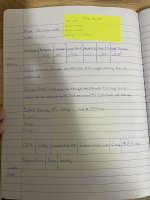My data book contains :
Blueprinted new brass ...ie unfired brass,brass manufacturer ,Head space ,case length ,neck O.D. - I.D. ,necks turned or not ,neck thickness ,flash holes deburred or not , primer pockets uniformed or not ,case head measurement ,assign a lot number,date, prepped brass weight ,probably forgetting something
Load workup : brass ,powder and grains ,primer ,bullet ,loaded neck O.D. , BTO and how far off lands it equals , OAL ,record lot number and number loadings / firings on brass ,fps ,ES ,SD,fired casehead measurement,Date,I haven't been recording, but need to start, temperature when shot ,sized and fired headspace, fired neck O.D. /I.D. ,CL , casehead,trimmed length if applicable,
Settled on load labeled on box : date loaded, lot number ,number of loading /firings ,Brass manufacturer, primer ,powder and grains ,bullet ,BTO ,average FPS, Loaded round total weight and spread ,notes on brass prep sometimes
I retain also, all my shot targets with enough info on them to know what was shot
I may or not do all the above case prep.....depends on my mood and purpose of use
The above has helped me retain what little sanity I still possess
ETA : I use post-it notes a lot ,to keep up with where I am so if I walk away for a while I'll know where I was ...... Same thing for seater dies.....ie what bullet was seated last time used.



